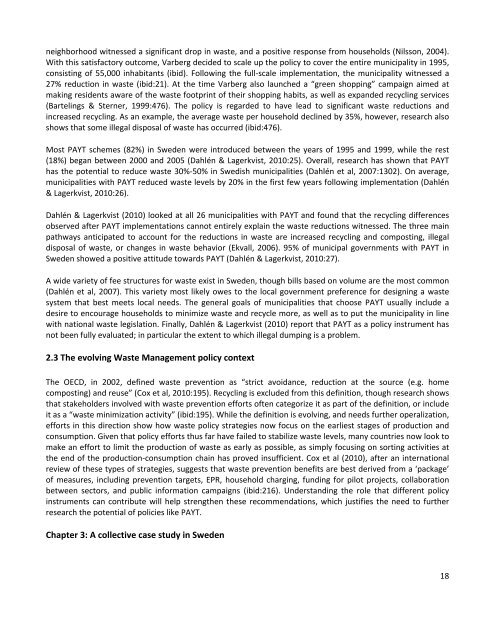Waste prevention and Pay as You Throw, a collective case ... - lumes
Waste prevention and Pay as You Throw, a collective case ... - lumes
Waste prevention and Pay as You Throw, a collective case ... - lumes
Create successful ePaper yourself
Turn your PDF publications into a flip-book with our unique Google optimized e-Paper software.
neighborhood witnessed a significant drop in w<strong>as</strong>te, <strong>and</strong> a positive response from households (Nilsson, 2004).<br />
With this satisfactory outcome, Varberg decided to scale up the policy to cover the entire municipality in 1995,<br />
consisting of 55,000 inhabitants (ibid). Following the full‐scale implementation, the municipality witnessed a<br />
27% reduction in w<strong>as</strong>te (ibid:21). At the time Varberg also launched a “green shopping” campaign aimed at<br />
making residents aware of the w<strong>as</strong>te footprint of their shopping habits, <strong>as</strong> well <strong>as</strong> exp<strong>and</strong>ed recycling services<br />
(Bartelings & Sterner, 1999:476). The policy is regarded to have lead to significant w<strong>as</strong>te reductions <strong>and</strong><br />
incre<strong>as</strong>ed recycling. As an example, the average w<strong>as</strong>te per household declined by 35%, however, research also<br />
shows that some illegal disposal of w<strong>as</strong>te h<strong>as</strong> occurred (ibid:476).<br />
Most PAYT schemes (82%) in Sweden were introduced between the years of 1995 <strong>and</strong> 1999, while the rest<br />
(18%) began between 2000 <strong>and</strong> 2005 (Dahlén & Lagerkvist, 2010:25). Overall, research h<strong>as</strong> shown that PAYT<br />
h<strong>as</strong> the potential to reduce w<strong>as</strong>te 30%‐50% in Swedish municipalities (Dahlén et al, 2007:1302). On average,<br />
municipalities with PAYT reduced w<strong>as</strong>te levels by 20% in the first few years following implementation (Dahlén<br />
& Lagerkvist, 2010:26).<br />
Dahlén & Lagerkvist (2010) looked at all 26 municipalities with PAYT <strong>and</strong> found that the recycling differences<br />
observed after PAYT implementations cannot entirely explain the w<strong>as</strong>te reductions witnessed. The three main<br />
pathways anticipated to account for the reductions in w<strong>as</strong>te are incre<strong>as</strong>ed recycling <strong>and</strong> composting, illegal<br />
disposal of w<strong>as</strong>te, or changes in w<strong>as</strong>te behavior (Ekvall, 2006). 95% of municipal governments with PAYT in<br />
Sweden showed a positive attitude towards PAYT (Dahlén & Lagerkvist, 2010:27).<br />
A wide variety of fee structures for w<strong>as</strong>te exist in Sweden, though bills b<strong>as</strong>ed on volume are the most common<br />
(Dahlén et al, 2007). This variety most likely owes to the local government preference for designing a w<strong>as</strong>te<br />
system that best meets local needs. The general goals of municipalities that choose PAYT usually include a<br />
desire to encourage households to minimize w<strong>as</strong>te <strong>and</strong> recycle more, <strong>as</strong> well <strong>as</strong> to put the municipality in line<br />
with national w<strong>as</strong>te legislation. Finally, Dahlén & Lagerkvist (2010) report that PAYT <strong>as</strong> a policy instrument h<strong>as</strong><br />
not been fully evaluated; in particular the extent to which illegal dumping is a problem.<br />
2.3 The evolving <strong>W<strong>as</strong>te</strong> Management policy context<br />
The OECD, in 2002, defined w<strong>as</strong>te <strong>prevention</strong> <strong>as</strong> “strict avoidance, reduction at the source (e.g. home<br />
composting) <strong>and</strong> reuse” (Cox et al, 2010:195). Recycling is excluded from this definition, though research shows<br />
that stakeholders involved with w<strong>as</strong>te <strong>prevention</strong> efforts often categorize it <strong>as</strong> part of the definition, or include<br />
it <strong>as</strong> a “w<strong>as</strong>te minimization activity” (ibid:195). While the definition is evolving, <strong>and</strong> needs further operalization,<br />
efforts in this direction show how w<strong>as</strong>te policy strategies now focus on the earliest stages of production <strong>and</strong><br />
consumption. Given that policy efforts thus far have failed to stabilize w<strong>as</strong>te levels, many countries now look to<br />
make an effort to limit the production of w<strong>as</strong>te <strong>as</strong> early <strong>as</strong> possible, <strong>as</strong> simply focusing on sorting activities at<br />
the end of the production‐consumption chain h<strong>as</strong> proved insufficient. Cox et al (2010), after an international<br />
review of these types of strategies, suggests that w<strong>as</strong>te <strong>prevention</strong> benefits are best derived from a ‘package’<br />
of me<strong>as</strong>ures, including <strong>prevention</strong> targets, EPR, household charging, funding for pilot projects, collaboration<br />
between sectors, <strong>and</strong> public information campaigns (ibid:216). Underst<strong>and</strong>ing the role that different policy<br />
instruments can contribute will help strengthen these recommendations, which justifies the need to further<br />
research the potential of policies like PAYT.<br />
Chapter 3: A <strong>collective</strong> c<strong>as</strong>e study in Sweden<br />
18
















